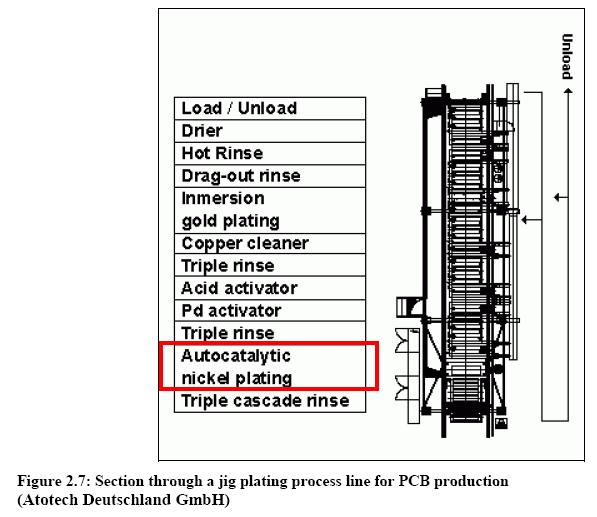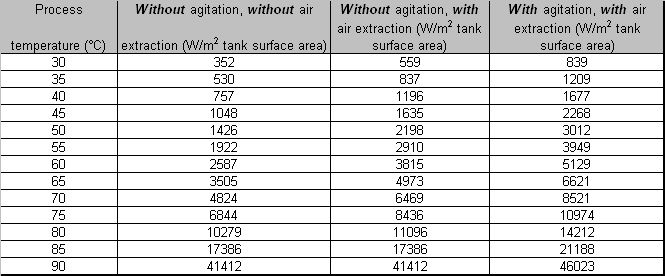Difference between revisions of "Autocatalytic plating in metal industry"
From Efficiency Finder
m (Protected "Autocatalytic plating in metal industry" [edit=autoconfirmed:move=autoconfirmed]) |
|||
| Line 17: | Line 17: | ||
*;Typical parameters of the process | *;Typical parameters of the process | ||
| − | + | {| border="1" | |
| − | [ | + | | align="center" style="background:#2266CC;"|'''Process''' |
| − | + | | align="center" style="background:#2266CC;"|'''Temperature [°C]''' | |
| + | | align="center" style="background:#2266CC;"|'''Heat transfer medium''' | ||
| + | | align="center" style="background:#2266CC;"|'''Residence time''' | ||
| + | | align="center" style="background:#2266CC;"|'''Chemicals''' | ||
| + | | align="center" style="background:#2266CC;"|'''Concentration''' | ||
| + | | align="center" style="background:#2266CC;"|'''Details''' | ||
| + | | align="center" style="background:#2266CC;"|'''Literature''' | ||
| + | |- | ||
| + | | style="background:#AACCEE;"| Autocatalytic nickel on metals|| align="center"| || align="center"| || align=”center”| || align=”center”| Nickel sulphate, nickel chloride|| align="center"| Nickel: 2-10 g/l|| align="center"| || rowspan="3" align="center"| BAT for the surface treatment of metals and plastics, August 2006 | ||
| + | |- | ||
| + | | style="background:#AACCEE;"| Autocatalytic nickel coating for plastics|| align="center"| || align="center"| || align=”center”| || align=”center”| Nickel sulphate or nickel chloride, reducing agents (sodium hypophosphite), dimethylaminoboreane and optionally chelating compounds|| align="center"| Nickel: 2-5 g/l; sodium hypophosphite: 5-20 g/l; dimethylaminoborane: >10 g/l|| align="center"| | ||
| + | |- | ||
| + | | style="background:#AACCEE;"| Autocatalytic copper on metals and plastics|| align="center"| || align="center"| || align=”center”| || align=”center”| Copper, sodium hydroxide, chelating agents (EDTA or tratrates) and reducing agents (formaldehyde) || align="center"| Copper: 2-5 g/l; sodium hydroxide: 15-20 g/l; chelating agents: 10-15 g/l; tartrates: 5-10 g/l; formaldehyde: 3-5 g/l|| align="center"| | ||
| + | |} | ||
Revision as of 11:55, 1 December 2010
Back to EFFICIENCY FINDER FOR METAL INDUSTRY
- Autocatalytic plating flowsheet
Literatur: BAT for the surface treatment of metals & plastics, 2006
- Typical parameters of the process
| Process | Temperature [°C] | Heat transfer medium | Residence time | Chemicals | Concentration | Details | Literature |
| Autocatalytic nickel on metals | Nickel sulphate, nickel chloride | Nickel: 2-10 g/l | BAT for the surface treatment of metals and plastics, August 2006 | ||||
| Autocatalytic nickel coating for plastics | Nickel sulphate or nickel chloride, reducing agents (sodium hypophosphite), dimethylaminoboreane and optionally chelating compounds | Nickel: 2-5 g/l; sodium hypophosphite: 5-20 g/l; dimethylaminoborane: >10 g/l | |||||
| Autocatalytic copper on metals and plastics | Copper, sodium hydroxide, chelating agents (EDTA or tratrates) and reducing agents (formaldehyde) | Copper: 2-5 g/l; sodium hydroxide: 15-20 g/l; chelating agents: 10-15 g/l; tartrates: 5-10 g/l; formaldehyde: 3-5 g/l |
- Energy losses from the surface area of heated process solutions
LITERATURE: BAT for the Surface Treatment of Metals and Plastics, May 2005

